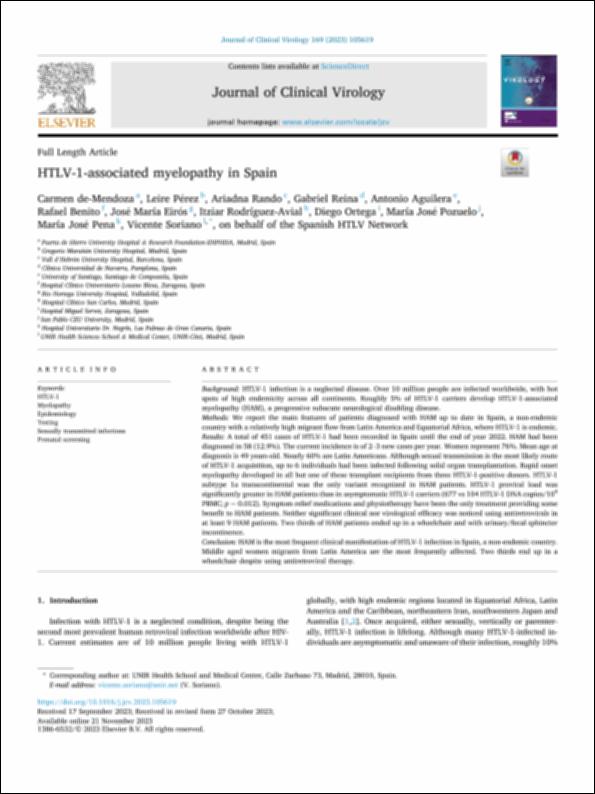Por favor, use este identificador para citar o enlazar este ítem:
http://hdl.handle.net/10637/15027HTLV-1-associated myelopathy in Spain
| Título : | HTLV-1-associated myelopathy in Spain |
| Autor : | Mendoza, Carmen de Pérez, Leire Rando, Ariadna Reina, Gabriel Aguilera, Antonio Benito, Rafael Eirós, José María Rodríguez-Avial, Itziar Ortega, Diego Pozuelo de Felipe, María José Pena, María José Soriano, Vicente HTLV Spanish Network |
| Materias: | Epidemiology; HTLV-1; Myelopathy; Prenatal screening; Sexually transmitted infections; Testing |
| Editorial : | Elsevier |
| Citación : | de-Mendoza C, Pérez L, Rando A, Reina G, Aguilera A, Benito R, Eirós JM, Rodríguez-Avial I, Ortega D, Pozuelo MJ, Pena MJ, Soriano V; Spanish HTLV Network. HTLV-1-associated myelopathy in Spain. J Clin Virol. 2023 Dec;169:105619. doi: 10.1016/j.jcv.2023.105619. Epub 2023 Nov 21. PMID: 38000189. |
| Resumen : | Background: HTLV-1 infection is a neglected disease. Over 10 million people are infected worldwide, with hot spots of high endemicity across all continents. Roughly 5% of HTLV-1 carriers develop HTLV-1-associated myelopathy (HAM), a progressive subacute neurological disabling disease. Methods: We report the main features of patients diagnosed with HAM up to date in Spain, a non-endemic country with a relatively high migrant flow from Latin America and Equatorial Africa, where HTLV-1 is endemic. Results: A total of 451 cases of HTLV-1 had been recorded in Spain until the end of year 2022. HAM had been diagnosed in 58 (12.9%). The current incidence is of 2-3 new cases per year. Women represent 76%. Mean age at diagnosis is 49 years-old. Nearly 60% are Latin Americans. Although sexual transmission is the most likely route of HTLV-1 acquisition, up to 6 individuals had been infected following solid organ transplantation. Rapid onset myelopathy developed in all but one of these transplant recipients from three HTLV-1-positive donors. HTLV-1 subtype 1a transcontinental was the only variant recognized in HAM patients. HTLV-1 proviral load was significantly greater in HAM patients than in asymptomatic HTLV-1 carriers (677 vs 104 HTLV-1 DNA copies/104 PBMC; p = 0.012). Symptom relief medications and physiotherapy have been the only treatment providing some benefit to HAM patients. Neither significant clinical nor virological efficacy was noticed using antiretrovirals in at least 9 HAM patients. Two thirds of HAM patients ended up in a wheelchair and with urinary/fecal sphincter incontinence. Conclusion: HAM is the most frequent clinical manifestation of HTLV-1 infection in Spain, a non-endemic country. Middle aged women migrants from Latin America are the most frequently affected. Two thirds end up in a wheelchair despite using antiretroviral therapy. |
| Descripción : | Acceso al texto completo del artículo, disponible desde el sitio de la revista usando DOI: https://doi.org/10.1016/j.jcv.2023.105619 Este artículo está en acceso abierto siguiendo la política de la revista |
| URI : | http://hdl.handle.net/10637/15027 |
| ISSN : | 1386-6532 |
| Fecha de publicación : | 21-nov-2023 |
| Centro : | Universidad San Pablo-CEU |
| Aparece en las colecciones: | Facultad de Farmacia |
Los ítems de DSpace están protegidos por copyright, con todos los derechos reservados, a menos que se indique lo contrario.


